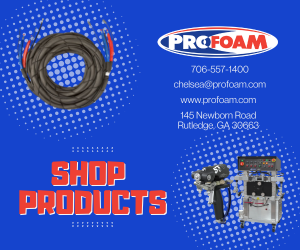Q&A Forums
Pour in place foam Post New Topic | Post Reply
| Author | Comments |
|---|---|
|
Posted: Sep 16, 2008 05:45 PM
|
Pour in place foam
We spray closed cell and open cell foam. We try to stay as current as possible on the new building and insulation methods. We have been asked over and over about insulating the existing exterior walls of homes with foam. Which would mean "pour in place, slow expansion foam". My thought has been that the process would create a potential for bowed sheet rock along the scenario of at least 10% to 20%. This is just my idea based on what we've seen with normal insulation projects. Up to 20% wall deformities caused by the foam would be a big problem. We've more or less insisted on a remodel project for existing wall work; however, We would like to ask for some advice based on other like minded foamers which have had some experience in this area. We would only be interested in products or methods which would produce consistant expansion that filled the cavity and produced results as advertised.Thanks for any help in this area. Talon |
|
Gerry Wagoner
Posted: Sep 18, 2008 07:44 AM
|
I have the same question. I expect that plaster would remain stable. |
|
Harry S
Posted: Sep 18, 2008 09:52 AM
|
Great question! I get quite a few calls myself for this type of job. Who is the foam supplier and what do they say? |
|
Gerry Wagoner
Posted: Sep 18, 2008 10:00 PM
|
Apex has a .5 lb slow rise. |
|
Posted: Sep 19, 2008 07:36 AM
|
Thanks for the input, we'll check out the Apex .5 lb. As with most situations, it would be nice if someone had some experience in this area and could reveal "the things they don't tell when you get into this stuff". We've learned some lessons along the way the hard way. Avoiding a few problems up front is good. Olger, if you've used this product before, do you have any comment about the application process or the results that you were able to achieve? I'll check with the manufacturer. When we select a slow expansion product, we plan to construct a test site for training. Until later. Talon |
|
Rob Granger
Posted: Sep 19, 2008 08:49 AM
|
Talon Bay systems also has a pour foam. You require a special; nozzle/tip for the AP gun that costs about $ 120. We have a job comming up in about two weeks, our first. We also decided to purchase injection foam equipment that works very well and material costs are substanial less than pour foam. We do a lot of housing retros. Check out cfifoam.com or airkrete. This type of foam might have better production results. Good Luck YES FOAM |
|
clint moore
Posted: Sep 19, 2008 05:39 PM
|
If I remember correctly from my construction days,houses have fire blocking that is installed and not always at the required places,How would you determine where and how much to put in? I guess you could use some type of metering system,but you still don't know how large or small the space is. Also where there is a electrical outlet,computer,phone,etc. that goes through the wall you will have foam coming out of it or into it. Foam when put into a mold will find the path of least resistance. Another thing,say you apply too much foam into a space and it can't expand,does it there for generate exothermic heat and begin to smolder? Just like if you were to pile it up in one spot. Anyway for what it's worth my two cents. |
|
Posted: Sep 20, 2008 08:25 AM
|
Maxx, You brought up several good points. We're aware of the obvious problems associated with the task of getting the foam in the walls with fire blocks, outlets, and expansion that doesn't fill the cavity. I'm sure that there are others' particularly the kind that working in an occupied home brings; however, many of us work in areas where older stately homes have exterior walls with little or no insulation in the walls. This is a common problem in the South and Southwest. What if along with insulating under the flooring, and insulating under the roof deck, you could also include insulating the exterior walls. If a proven method is available, we've increased our income potential. This type of project could become that extra that changes a job from "OK" to profitable. If they're lined up, and waiting, then the work could be a "filler" when you're slow. We've all had specialty projects that brought us additional work later. Maxx, we are like you in that we see the obstacles, but someone will do this and make it look easy one of these days. Thanks for the input, we're trying to improve our service, and any input is certainly welcome. Until later. Talon |
|
Jim Coler
Posted: Sep 22, 2008 07:13 AM
|
We've tried it but it's not as easy as it's made out to be. We've also been approach to be an Airkrete installer, but I chose not to because once it sets up, it's a brittle material and will likely stel over time with the movement of the house and wood. Yes, they do have problems with it coming out of the outlets and filling them. I've heard a number of guys who had to dig it out and replace multiple outlets because of this. Expanding too fast and popping the drywall is a very real issue. It really depends on how many screws/nails are in the drywall/plaster and what the drywall thickness is. We've had it pop and crack and blow out. It tends to be a very invasive procedure which isn't cheap or all that profitable for the installers or the homeowner. We've stayed away from it for these reasons - even though we did try it just for curiosity sake. |
|
Posted: Sep 22, 2008 07:27 AM
|
Thanks Guys, That's the kind of input I hoped for, the companies that we've talked to so far have not be all that encouraging. We're getting information that's leads us to a product, then the discussion with the company makes you feel like you would be on your own if you had problems. They have the product, but they're not pushing the product, they're pushing the school for their products. Thanks again for the "stuff they don't tell you" information. Talon |
|
clint moore
Posted: Sep 22, 2008 10:30 AM
|
Add to your skill list; drywall hanger,taper,painter,electrician,plumber,glass replacement,roofer,siding installer,insurance salesman,etc...you can insulate storage units,containers,truck boxes(not tool boxes),outside of buildings before stucco,sprayfoam roofing,wells,manholes. What about plural componant coatings like polyureas,you can coat almost anything. Injection moldings,water towers,mining shafts,construct landscaping(the stuff at the Zoo ain,t real),the list goes on and on and on,how creative are you,it's endless.Do you want to make money or limit the potential? |
|
steve loftis
Posted: Sep 22, 2008 09:59 PM
|
using a pour foam in a mold or structure capable of holding in the expansion pressure is easy. When compressed, even light density foams will produce a tremendous amount of expansion pressure and can easily bow or break drywall. Injecting pour foam into a "blind" cavity is very tricky so no manufacturer will advise doing it routinely unless the void has very strong walls, such as masonry cavities. Many have tried it and done it successfully a number of times but the one failure cost them and has bankrupted more than one good spray foam contractor. Some jobs are just best left alone. |





























